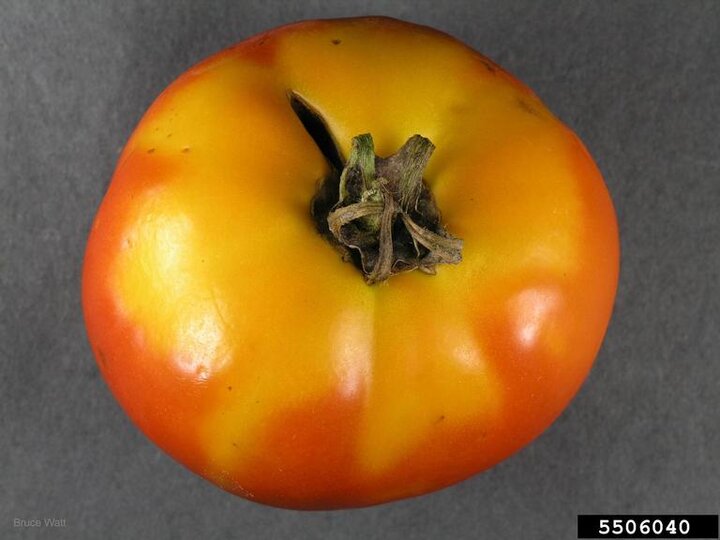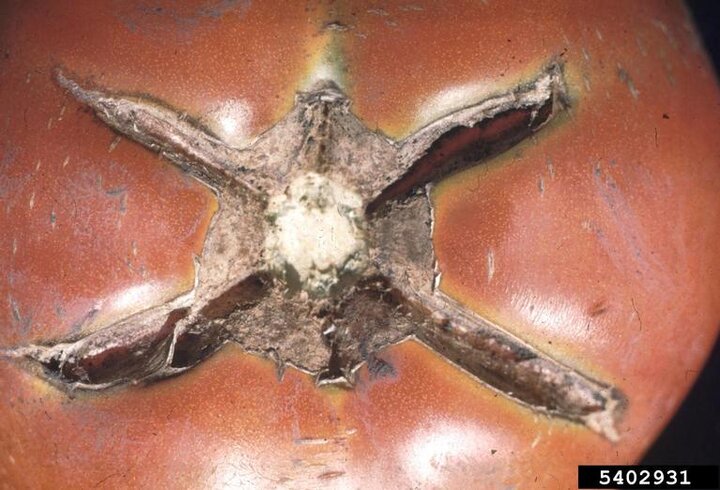Sarah Browning, Nebraska Extension Educator

Blossom end rot, Image by Brenda Kennedy, University of Kentucky.
Finally, it’s tomato harvest season! You’ve tended your plants through cool, cloudy spring conditions into summer’s heat and they’ve done great. Now you finally have tomatoes ripening and ready for harvest. But wait – they have cracks, yellow shoulders and white spots; what is wrong now?
It’s amazing how many problems can plague on our favorite garden vegetable. Fortunately, most problems don’t make the tomatoes inedible and can be managed. Trim away the damaged tomato section and the rest is fine to eat. Let’s take a look at some of the most common, including blossom end rot, ripening problems and fruit cracking.
Blossom end rot (BER) is a common problem of tomatoes, but is also found on peppers, eggplant, squash and watermelon. It appears as a flat, dry, sunken, brown rot that is seen on the blossom end of the fruit, opposite the stem end. The rot is first seen as a small, water-soaked spot on the base of half-developed fruits and continues to enlarge as the fruit matures. The size of the rotted area varies, but can cover up to 50% of the fruit. BER is a physiological disorder causes by a calcium deficiency in the developing fruit.
Calcium is an important component for normal cell wall development; when inadequate levels of calcium are available to the rapidly developing young tomato, the result is cell breakdown. This condition is rarely the result of a lack of calcium in the soil, but rather occurs when plants cannot pull up calcium quickly enough for the developing tissues. Calcium is a nutrient with limited mobility in plants; it must be dissolved in water to move well, so water deficits are a frequent contributing factor. The tomato’s blossom end has fewer vascular bundles, pathways that move water and nutrients from one part of the plant to another, so are most susceptible to a lack of calcium.
Drought stress, low daytime humidity, high temperatures and rapid, vegetative plant growth caused by excess nitrogen applications favor BER development. Drought stress and low daytime humidity cause plants to lose large amounts of water through transpiration, resulting in more water being sent to the leaves and less to the developing fruits. High temperatures contribute to this condition by causing faster fruit enlargement, and a greater need for calcium.
Cultural techniques that can be used to reduce BER include the following:
- Prevent drought stress on plants through good irrigation practices. Provide at least 1 inch of water per week, and greater amounts for plants in sandy soils or during very hot, dry conditions
- Use an organic mulch
- Avoid over fertilization
Foliar applications of calcium have little effect on this condition, due to the poor absorption and movement of calcium from the leaves to the fruits.

Yellow shoulder is often seen in heirloom tomato cultivars, where the trait has not been improved through plant breeding. Symptoms include hard yellow or green tissue around the tomato stalk, while the rest of the tomato is the proper ripe color and firmness. Internally these areas of the tomato are often white or green, but the fruit is still edible if the discolored sections are trimmed away.
Conditions leading to yellow shoulders are a complex blend of environmental conditions and plant physiology, but it is very common during periods of high temperatures. The shoulders of tomato, or the top edges of the fruit, are often exposed to the most heat and sun, so are most prone to the problem. Maintain good soil moisture and fertility. Or harvest fruits at the pink stage and allow them to finish ripening indoors, away from outside stresses. This often helps the tomato ripen more evenly. Choose cultivars in the future with less susceptibility to yellow shoulders.
Uneven or blotchy ripening is similar to yellow shoulders, but other areas of the tomato remain yellowish or orange instead of turning the normal ripe color. It’s caused by low temperatures, compacted or overly wet soil, which inhibits root growth and health, viral diseases and heavy whitefly infestation.
Failure to ripen happens most often in fall when temperatures drop below 60 F degrees or in mid-summer when daytime temps are above 90 F degree. Compacted or overly wet soil and low soil potassium also play a part in this disorder.

Diagnostic Help at Your Fingertips
These and many more tomato problems are discussed in two great online resources listed below. Both include pictures to illustrate the typical symptoms of each disorder and management tips for your garden.
- Tomato Fruit Problems, from the Missouri Botanical Garden.
- Tomato Diseases and Disorders, Iowa State University.
Images:
- Blossom end rot, from Brenda Kennedy, University of Kentucky.
- Tomato yellow shoulder, from Bruce Watt, University of Maine.
- Tomato shoulder cracking, from R.W. Samson, Purdue University.
Search Our Archive
Associated Video
Special Tomato Problems
Nebraska Extension Educator Sarah Browning shows us different problems that can arise when growing tomatoes and helps us avoid them.<br />